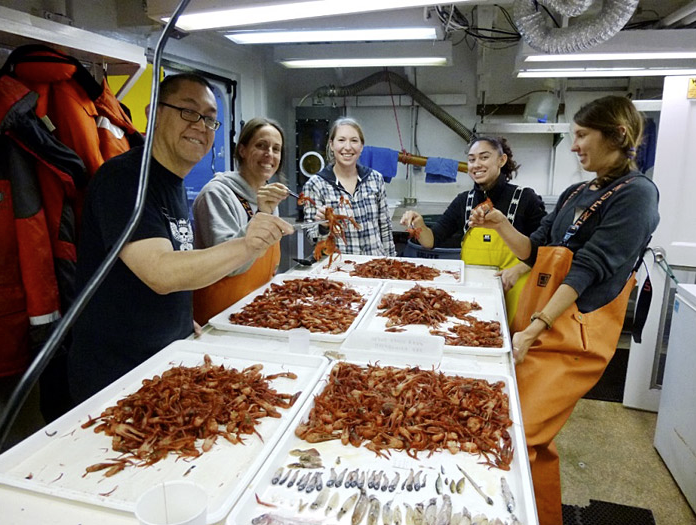
The Southwest Fisheries Science Center (SWFSC) Fisheries Ecology Division’s Rockfish Recruitment and Ecosystem Assessment Survey concluded on June 14, 2015 in San Francisco, completing the 33rd year of evaluating the abundance and distribution of pelagic young-of-the-year (YOY) rockfish (Sebastes spp.) and other groundfish off central California and the 11th year of sampling off southern and northern California. The 2015 survey was conducted on the R/V Ocean Starr, with biologists from NOAA, the University of California Santa Cruz, the Farallon Institute for Advanced Ecosystem Research and other institutions spending six weeks at sea and completing 168 pelagic midwater trawls, 246 CTD casts and 116 plankton tows. Continuous acoustic data and seabird and marine mammal distribution and abundance data were also collected.
The 2015 survey year continued a trend of high catches of rockfish, other YOY groundfish and market squid (Doryteuthis opalescens) observed in recent years, although catches of krill (a key forage species) were lower than observed in recent years. However, catches of warm water species were also anomalously high, with very large catches of species typically only observed during strong El Niño events (or never previously observed on this survey), such as pelagic red crabs (Pleuroncodes planipes), pelagic octopus (Argonauta arga), the slender snipefish (Macroramphosus gracilis), and the subtropical krill Euphausia eximia. Finally, despite such warm water species, there were also very high catches of gelatinous zooplankton, such as salps (Salpa spp., Thetys vagina), pyrosomes and heteropods.
Throughout the history of this survey we have tended to see three very generalized patterns of community dominance. For example, in years of strong upwelling and/or southward transport, we see productive conditions associated with high numbers of YOY rockfish, market squid and other key elements of the food web. In contrast, in years of lower upwelling and transport (such as El Niño years), we often see greater localized abundance of coastal pelagic species such as Pacific sardine (Sardinops sagax) and northern anchovy (Engraulis mordax) and an increase in the abundance of typically subtropical species such as pelagic red crabs (Pleuroncodes planipes). Finally, in some years the community is dominated by gelatinous zooplankton, such as salps, pyrosomes and heteropods. The 2015 survey was unusual in that species characteristic of all three of these nominal states were encountered in high abundance throughout central and southern California, highlighting the unusual nature of ocean conditions throughout the spring of 2015. A more comprehensive analysis of the 2015 survey results relative to previous years is ongoing.
Learn more:
2015 cruise report
Sakuma, Keith. 2015. Cruise report, Ocean Starr OS-15-05, April 30 – June 14, 2015: Rockfish recruitment and ecosystem assessment, Fisheries Ecology Division, NOAA NMFS SWFSC. National Marine Fisheries Service, Santa Cruz, California. 18 p.
Contact: SWFSC Fisheries Ecology Division, Groundfish Analysis Team
(Originally reported June 24, 2015)